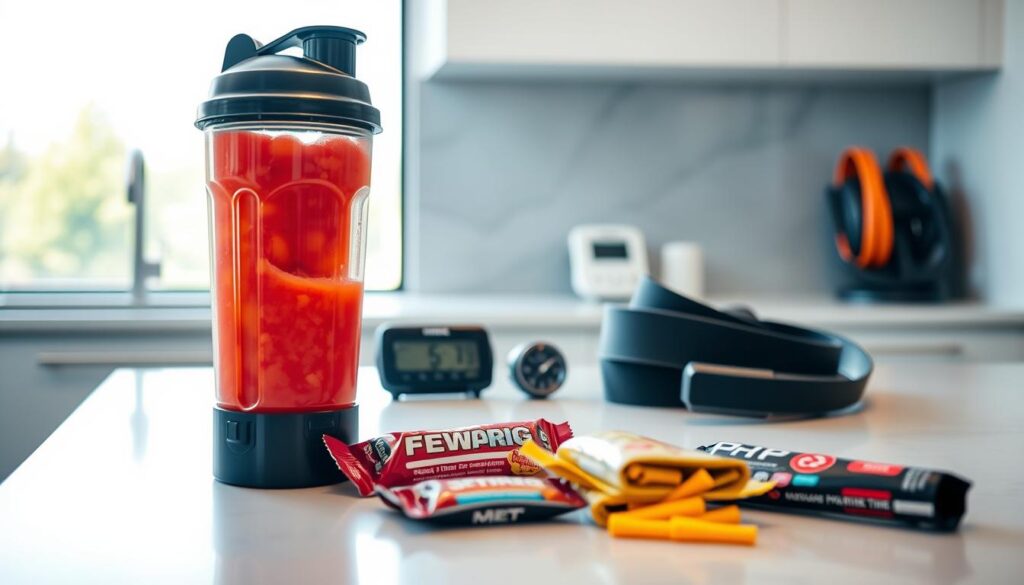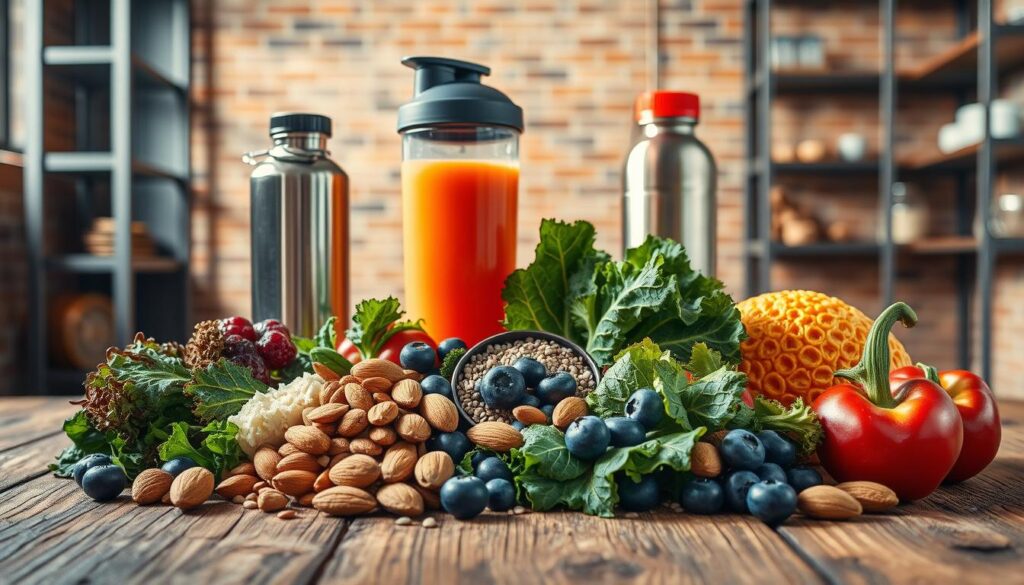Ever finish a training session feeling like you hit a wall halfway through? That sudden crash isn’t just about pushing harder—it’s about what you feed your engine. Think of your muscles like a sports car: even the best models sputter without premium gas. I learned this the hard way after months of plateauing, until a simple shift in my nutrition strategy turned grueling sessions into breakthroughs.
What you eat isn’t just background noise—it’s the difference between surviving a workout and dominating it. Your system needs the right mix of nutrients to sustain explosive moves and rapid recovery. Forget strict meal plans or timing obsessions. This is about smart choices that keep energy steady from warm-up to cool-down.
Timing matters, but so does flexibility. A pre-workout snack isn’t magic—it’s science. Hydration isn’t optional—it’s your secret weapon. And recovery? That’s where gains actually happen. Let’s cut through the noise and focus on what your unique physiology demands during sweat-drenched, heart-pounding efforts.
Key Takeaways
- Nutrient timing boosts energy levels during tough sessions
- Hydration impacts performance more than most realize
- Post-workout recovery starts with strategic fueling
- Simple food swaps can prevent mid-workout crashes
- Personalized approaches beat one-size-fits-all plans
The Importance of Proper Nutrition for High-Intensity Exercise
Your plate holds more power than you think during sweat-drenched training. What you eat directly impacts whether you finish strong or fade halfway through. Smart food choices act like premium fuel, keeping your engine roaring through every sprint, lift, and jump.
Energy, Performance, and Recovery Explained
Nutrition works like a three-part system for athletes. Energy comes from breaking down food into usable fuel. Performance depends on how well your muscles access that fuel during explosive moves. Recovery kicks in post-workout, repairing tissues and restocking energy reserves.
Carbs provide quick-burn energy for sprints or weightlifting. Proteins rebuild muscle fibers after they’re stressed. Fats keep your hormones balanced and support longer sessions. Miss one piece, and your results stall.
The Role of Carbohydrates, Proteins, and Fats
Each macronutrient plays distinct roles in powering your workouts:
| Nutrient | Primary Role | Best Timing | Top Sources |
|---|---|---|---|
| Carbohydrates | Instant energy for bursts | Pre/during workout | Oats, bananas, rice |
| Protein | Muscle repair & growth | Post-workout | Eggs, Greek yogurt, chicken |
| Fats | Sustained energy & hormones | Rest days/long sessions | Avocados, nuts, olive oil |
Carbs fire up your immediate energy needs. Proteins act as building blocks for stronger muscles. Fats keep your metabolic engine humming during endurance challenges. Balance all three to crush personal records.
How to Fuel Your Body for High-Intensity Workouts: Pre-Workout Guidelines
Your pre-exercise routine starts long before you lace up your shoes. Smart timing and food selection create an energy pipeline that powers explosive movements while keeping stomachs settled.

Timing Your Meal and Choosing the Right Foods
Aim to eat 2 hours before exercise for optimal digestion. Whole-grain toast with almond butter or oatmeal with berries provides steady energy. Research shows meals consumed 1-4 hours pre-workout enhance performance.
Short on time? Grab a banana 5-10 minutes before starting. Simple carbs digest quickly, avoiding energy crashes. Avoid heavy proteins and fats—they divert blood flow from muscles to your gut.
Hydration Strategies Before You Exercise
Start sipping water 4 hours pre-session according to ACSM guidelines. Add a pinch of salt to enhance fluid retention if sweating heavily. Electrolyte drinks work well for sessions exceeding 60 minutes.
Monitor urine color—pale yellow means you’re hydrated. Darker shades signal the need for more fluids. Overhydration dilutes electrolytes, so balance intake with your sweat rate.
During-Workout Nutrition for Sustained Energy
When your heart rate spikes and sweat pours, every calorie counts. Sessions exceeding 60 minutes demand strategic fueling to combat glycogen depletion—your muscles’ primary energy reserve. The International Society of Sports Nutrition confirms intense exercise drains these stores, requiring 30-90 grams of carbs hourly to maintain power output.

Selecting Quick and Easily Digested Carbs
Choose foods that convert to energy fast without stomach protests. Bananas deliver natural sugars in 15-20 minutes. Raisins pack concentrated carbs in bite-sized portions. Low-fat yogurt offers dual benefits—quick fuel plus protein for muscle preservation.
Maintaining Electrolyte Balance with Fluids
Hydration isn’t just about water. Sip electrolyte-enhanced drinks during sessions lasting 90+ minutes. Sodium replaces what’s lost through sweat, while potassium prevents cramping. Avoid gulping large amounts—small, frequent sips prevent sloshing.
Tips for Mid-Workout Energy Boosts
Time carb intake every 20-30 minutes during endurance efforts. Portable options like energy gels or dried fruit fit seamlessly between sets. For shorter sessions? Focus on pre-exercise meals—your stored energy suffices for 45-minute circuits.
Post-Workout Recovery: Refuel and Replenish
The final beep of your fitness tracker signals more than just session completion—it’s go-time for strategic refueling. Your body enters a metabolic window where nutrients get prioritized for repair and growth. Ignore this phase, and you’ll miss half the benefits of your sweat session.
Power Pairing: Carbs + Protein
Within 60 minutes post-exercise, aim for a 3:1 ratio of carbs to protein. Whole-grain toast with scrambled eggs or Greek yogurt with berries works perfectly. This combo:
- Restores glycogen 40% faster than carbs alone (Journal of Applied Physiology)
- Triggers muscle protein synthesis within 2 hours
- Reduces next-day soreness by 25%
Smart Fat Integration
While immediate post-workout focus stays on carbs/protein, healthy fats play the long game. Add avocado to your turkey wrap or sprinkle walnuts on oatmeal 2-3 hours later. These fats:
- Enhance absorption of fat-soluble vitamins
- Support hormone production for muscle growth
- Provide sustained energy for future sessions
“Recovery nutrition isn’t optional—it’s where transformation happens,” notes sports dietitian Dr. Ellen Manning. Pair grilled salmon with quinoa and roasted veggies for a meal that checks all boxes: fast-acting carbohydrates, complete amino acids, and anti-inflammatory omega-3s.
Additional Tips for Enhancing Workout Performance
Maximizing your gym efforts requires more than just showing up—it demands precision in both movement and nutrition. Small tweaks to your routine can amplify results, whether you’re chasing endurance milestones or building raw strength.
Incorporating Supplements and Adjusting Intake
Pre-workout boosters like creatine and caffeine sharpen focus and delay fatigue. Studies show these nutrients enhance performance by 5-15% when timed 30-45 minutes pre-exercise. But remember:
- BCAAs preserve muscle during endurance exercises
- Beta-alanine buffers lactic acid in high-intensity bursts
- Multi-ingredient blends offer convenience but check labels
“Supplements fill gaps—they don’t replace real food,” warns sports nutritionist Dr. Alicia Renn. Always consult a healthcare pro to avoid clashes with medications or sensitivities.
Customizing Nutrition to Fit Your Exercise Style
Endurance athletes thrive on carb-heavy plans (6-10g per kg body weight), while strength trainers prioritize protein (1.6-2.2g per kg). Your plate should mirror your primary goals:
- Sprinters: Fast-digesting carbs + lean proteins
- Weightlifters: Slow-release proteins + healthy fats
- Cross-trainers: Balanced macros with electrolyte focus
Track how different food sources impact energy levels. A cyclist might need bananas mid-ride, while a powerlifter benefits from cottage cheese post-session. Adjust portions based on training intensity—longer sessions demand more fuel.
Conclusion
Finding your ideal nutrition strategy takes experimentation. While carb timing and protein ratios matter, your digestive system and training style dictate what works. A powerlifter might thrive on sweet potatoes and chicken, while a sprinter prefers rice cakes with almond butter.
Balance remains universal. Pair quick-energy fruits like bananas with sustaining nuts for longer sessions. Hydration supports every rep – sip electrolyte drinks during sweaty circuits. For optimal workout nutrition, adapt these principles to your schedule and cravings.
Remember: food fuels progress, not perfection. Track how oatmeal versus toast affects your morning sprints. Notice if adding avocado to post-workout salads reduces next-day soreness. Your body’s signals – sustained energy, faster recovery – guide better than rigid rules.
Nutrition and exercise form a feedback loop. Feed muscles wisely, and they’ll power through burpees and deadlifts. Neglect recovery meals, and progress stalls. Test, adjust, repeat – that’s how champions build lasting strength and endurance.
